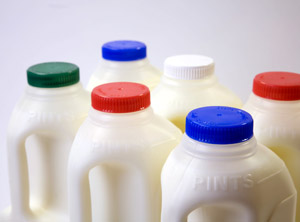ARLA FOODS
Plans to introduce HDPE stretch blow moulded bottles / Initial application for niche product lines / Lower carbon footprint
 Using HDPE for milk bottles will allow Arla to incorporate up to 50% of rHDPE (Photo: Nampak) |
Dairy products manufacturer Arla Foods (Leeds / UK; www.arlafoods.co.uk) is preparing to become the world’s first dairy company to launch HDPE injection stretch blow moulded bottles for milk. It has been working closely with leading machinery suppliers on the technology, which will be used initially for niche product lines, such as flavoured milks, in smaller size bottles. Extrusion blow moulding will continue to be the production process for all its standard milk bottles.
Injection stretch blow moulding (ISBM) with HDPE has environmental advantages when compared with PET, Arla says. These include a lower carbon footprint, full recyclability and the potential to incorporate up to 50% rHDPE. This will, according to packaging technologist Phil O’Driscoll, allow Arla to harness all the benefits of the ISBM production process without the high environmental cost associated with PET. Last year Nampak Plastics Europe (Newport Pagnell, Buckinghamshire / UK; www.eu.nampak.com) paved the way for increased rHDPE content in milk bottles when it commissioned its new manufacturing plant in Northern Ireland – see Plasteurope.com of 17.03.2010.
HDPE bottles produced by ISBM have a similar opacity to those made using extrusion blow moulding. However, the matt finish obtained with extrusion blow moulded bottles is replaced by a shiny, glass-like finish when the bottles are stretch blown. Also, says O’Driscoll, they have the benefit of an injection moulded neck, providing more positive sealing characteristics. Consumer response to the ISBM bottles is reported to be very positive.
“We are really pushing the boundaries in terms of packaging innovation,” O’Driscoll explained, “and this option offers consumers an attractive and environmentally friendly solution, making it ideal for added-value products.” The development is ongoing, the packaging expert added, and ISBM is only one of many new technologies Arla is exploring as it seeks to optimise its packaging portfolio.
Injection stretch blow moulding (ISBM) with HDPE has environmental advantages when compared with PET, Arla says. These include a lower carbon footprint, full recyclability and the potential to incorporate up to 50% rHDPE. This will, according to packaging technologist Phil O’Driscoll, allow Arla to harness all the benefits of the ISBM production process without the high environmental cost associated with PET. Last year Nampak Plastics Europe (Newport Pagnell, Buckinghamshire / UK; www.eu.nampak.com) paved the way for increased rHDPE content in milk bottles when it commissioned its new manufacturing plant in Northern Ireland – see Plasteurope.com of 17.03.2010.
HDPE bottles produced by ISBM have a similar opacity to those made using extrusion blow moulding. However, the matt finish obtained with extrusion blow moulded bottles is replaced by a shiny, glass-like finish when the bottles are stretch blown. Also, says O’Driscoll, they have the benefit of an injection moulded neck, providing more positive sealing characteristics. Consumer response to the ISBM bottles is reported to be very positive.
“We are really pushing the boundaries in terms of packaging innovation,” O’Driscoll explained, “and this option offers consumers an attractive and environmentally friendly solution, making it ideal for added-value products.” The development is ongoing, the packaging expert added, and ISBM is only one of many new technologies Arla is exploring as it seeks to optimise its packaging portfolio.
07.03.2011 Plasteurope.com [218754-0]
Published on 07.03.2011
